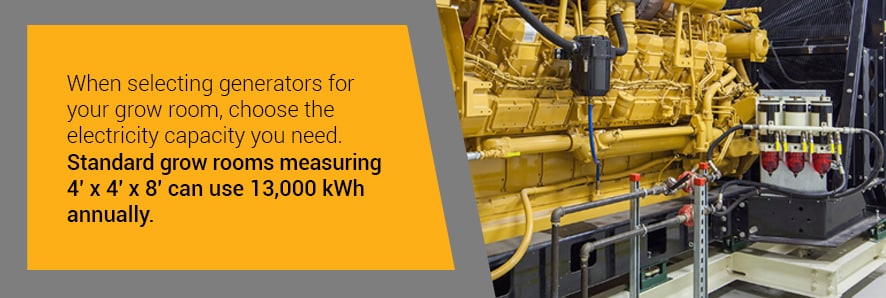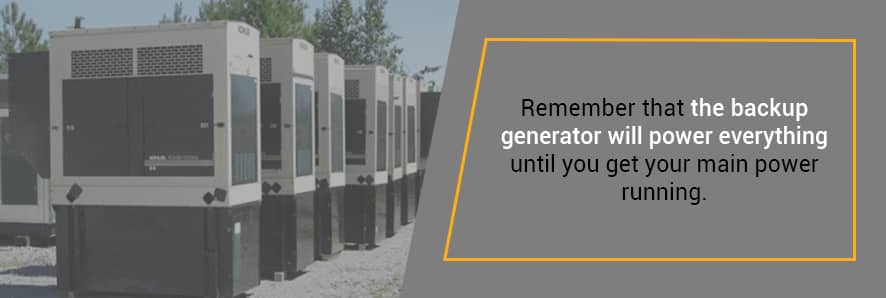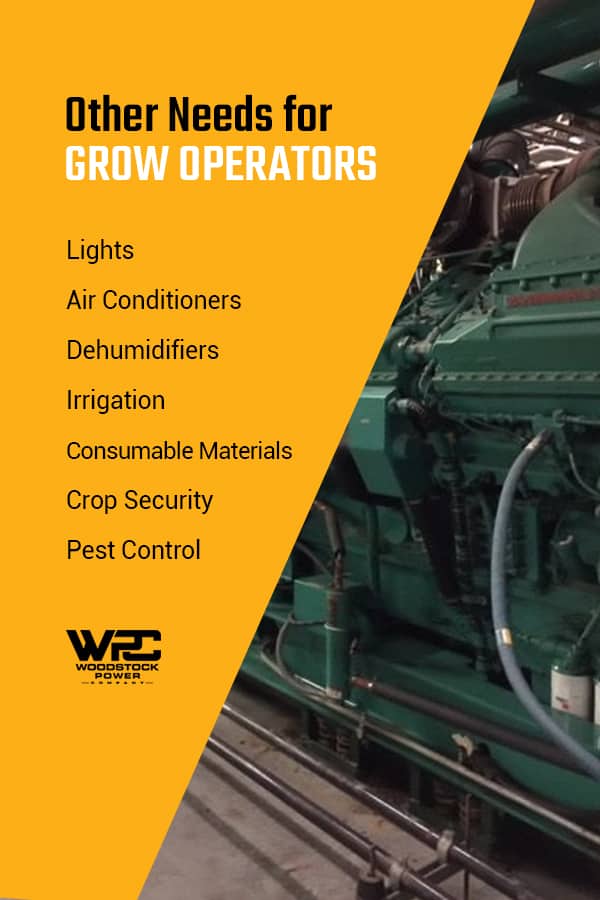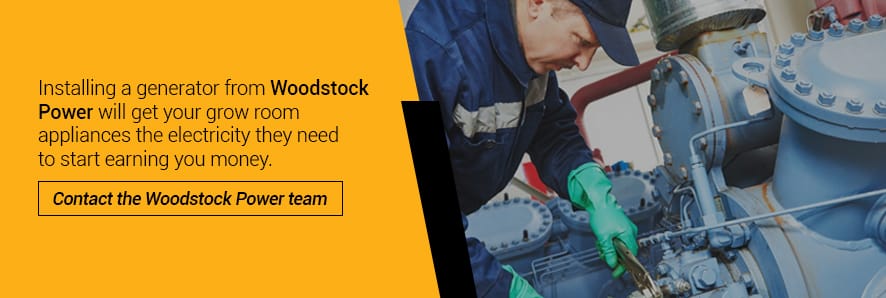Important Items to Consider Before Starting a Grow Op

Starting a grow operation can be a lucrative business venture, but you need to consider the setup costs before you even consider income generation. Grow rooms allow for the cultivation of a variety of plants regardless of the weather and climate your area experiences. Growing cannabis is an intricate operation that relies heavily on consistently steady power to conduct successful growth. The risk of rolling brownouts and blackouts that last even a single hour can negatively impact your crop, resulting in devastating losses.
Maintaining the right conditions for the cannabis plants to thrive and survive requires considerable power – often more than your building can supply.
Commercial Generators for Grow Rooms
As the cannabis industry continues to steadily grow, there has been a strong emphasis on the importance of commercial generators for grow ops. Due to the high demand of electricity placed on a facility, many grow operators have switched to commercial generators as a sole power source.
Grow rooms require a multitude of electrical equipment, including UV lights, dehumidifiers, air conditioners, automatic irrigation systems, and similar appliances that help regulate the climate and environment for cannabis plants to thrive in. Without reliable power, these devices will fail to operate, resulting in reduced crop yield or complete loss of crop.

Choosing Generators for Your Grow Room
1. Power Considerations
When selecting generators for your grow room, choose the electricity capacity you need. Standard grow rooms measuring 4’ x 4’ x 8’ can use 13,000 kWh annually. More extensive facilities require even more power. Electricity use density can reach 2,000 watts per square meter. This power density almost equates to the high energy needs of data centers. In addition to this power requirement, plan at least 10% over this amount to allow for future growth and scaling of your operation.
2. Cost Considerations
The generator serves the most crucial purpose for your grow room. Whether serving as a backup power solution in the event of a power outage or used as a primary power source – an incorrectly sized generator can result in failure to maintain ideal conditions for growing. Choosing a low-quality generator or a generator with a low output rating to save money can cost you far more in lost production and reduced crop output.
Instead of compromising quality and power output to save money, consider purchasing a used generator. A used generator that was regularly serviced & maintained can be just as reliable as a new generator, as well as considerably cheaper than buying new. In addition to saving money on acquiring a generator, you can also save time! New generators are usually built to order, which means longer lead times of receiving your generator. Used generators are usually readily available to ship immediately, meaning you can start planting crops and reaping the growth of your harvest faster!

Backup Generators for Grow Rooms
Knowing how critical having a generator is to your operation, are you prepared with a plan for power outages? What happens if you run out of fuel for your generator? Do you have a contingency plan for a natural disaster? A backup generator could save your crop and harvest from failure if the main power goes out.
When selecting a backup generator, the single biggest mistake is selecting an undersized generator. Remember that the backup generator will need to power everything necessary to continue grow operations until the main power comes back up. If the energy draw is too high on the backup generator, the equipment, systems, and machinery connected to it could fail to power.
While installing a backup generator will add to your commercial grow room setup costs, not having one can lead to dire consequences.
Running Generators In Parallel
There is also the option of running generators in parallel.
Running generators in parallel is when you install multiple smaller generators. Running generators in parallel requires more space but provide redundancy, longer intervals between maintenance periods, and overall lower fuel costs. Due to running generators in parallel, there is also the advantage of running less generators together at one time due to varying demands in load.
A good example, for instance, would be if your estimated calculations of power needs, a 300 kW generator would be required. If you were to install a single, large 300 kW generator that were to provide 100% of the power for your grow ops, it would need to be shut off during periods of generator service & maintenance, which would grind operations to a halt. Whereas you could install 6 smaller 50 kW generators to run in parallel and configured to operate together at around 84% of your generator needs, while some generator units are shut down for service & maintenance. This ensures that operations can continue in a certain capacity regardless of whether any of the 6 units are being serviced.
More information on running generators in parallel can be found here:
https://woodstockpower.com/blog/grow-ops-benefits-of-running-generators-in-parallel/
https://woodstockpower.com/blog/logic-behind-running-generators-parallel/
https://woodstockpower.com/blog/generator-paralleling/
Cost of Not Having a Backup Generator
While not having an appropriate sized backup generator can cause problems, you’ll find yourself paying more for not having a backup at all. When your primary power source goes out, if you don’t have a backup option to keep your grow lights, air condition, dehumidifier, and other machinery running, your crop could experience a rapid failure.
Instead of maintaining a consistent climate inside the grow room, you’ll have the equivalent of a sudden weather change and internal climate. Grow rooms are designed to help avoid the problems of sudden storms or freezes that farmers have to deal with when raising crops outdoors. This all means nothing if you cannot regulate the grow room to optimal condition.
A power outage without a backup generator removes the protection and control of the grow room, putting your plants at risk of exposure to uncertain, uncontrollable conditions. This often results in reduced yields of plant death. If you have a backup power source, such disastrous scenarios can be avoided.

Other Needs for Grow Operators
Once you have a power source, other machines will contribute to the cost to start a grow operation. This other equipment all serves different functions in keeping your plants healthy. Neglecting to purchase the correct type could jeopardize your operation’s success.
1. Lights
Because you’re growing indoors, you cannot rely on sunlight to provide your plants with the source of food they need. Grow lights stand-in for the sunlight your plants don’t get. Unlike outdoor plants that only get sunlight on sunny or partly cloudy days, your artificial lighting provides the basics for your plants to make food no matter the weather outside. During the darker months of the winter, when sunlight hours grow shorter, grow lights make it possible to increase your growing season and harvest yield.
Depending on the size of the room, you may need several large lights. These fixtures generate considerable heat, making it uncomfortably hot for the workers in the room. If the temperature rises too much, your crops could suffer or require extra water, wasting resources. Air conditioners may help with this problem.
The lighting you choose will affect the cost to cool the grow room. For example, if you select cooler-operating LED lights, you can save up to 50% on your cooling costs. The downside to LED lights is their higher cost. But these lights run longer than incandescent or fluorescent lights, requiring fewer bulb changes and less energy to keep them lit.
2. Air Conditioners
Air conditioners help keep the grow room cool enough for workers while preventing overheating from the grow lights. The size of the grow room and its temperature will help you select an appropriate air conditioner unit. More substantial units that need to run longer will use more electricity, and your generator must have the capacity to keep up.
When sizing air conditioners for your operation, do not plan to maximize their use. If you run an HVAC system 24 hours a day at its coldest setting to drop the temperature in the grow room a few degrees, you are using the system inefficiently. More energy-efficient models allow you to get the cooling you need while using only 80% of their capacity. The extra capacity of the system allows for use during especially hot days or to expand your operations.
When planning your growing operation, no more than 10% to 25% of your initial investment should go toward the HVAC system. This amount should allow you to purchase a customized system for the grow room while opting for the highest possible energy efficiency to reduce operating costs.
Maintaining the HVAC system and paying for it to operate throughout the year could cost 20% of your budget, as it does for other indoor growers. The temperature control you get will help maximize your crop yield, helping to offset the cost of cooling.
Additionally, there are systems available that allow you to time and control when your air conditioner will run to operate on maximum efficiency and create the ideal temperate climate for your crops.
3. Dehumidifiers
While chillers and air conditioners remove some humidity from the air, you will likely find the space still too humid for comfortable operation. Excessively high moisture levels in the air could promote mold growth on your crops, especially if you don’t have fans circulating the air. To reduce this problem, you will need dehumidification equipment.
Not having a dehumidifier could ruin your crop. One grower predicts crop losses of up to 50% due to mold from excessive humidity. Though it may increase your investment cost, a dehumidifier can save you by preventing harvest reduction.
4. Irrigation
While paying for the cost of an automated irrigation system may not seem like a way to save money, the one-time investment will result in compounding savings from labor. An automatic sprinkler system can water all the plants in your grow room at once instead of taking hours to water the plants by hand.
For a 100,000-square-foot grow room with 16,000 plants, the time to water the whole crop at five seconds per plant would equal 22 hours. You cannot afford to dedicate a single worker to such a monumental task, especially not when automated sprinklers don’t over- or under-water plants, instead providing the entire crop with the same amount of water.
5. Consumable Materials
Other types of materials you will need to factor into your startup costs include the plants, growing medium, water and fertilizer. While you can’t eliminate or substitute most of these consumables, you can make your own fertilizer and save up to 95% off the cost compared to commercial products.
Mixing your fertilizer ensures you have the proper combination of ingredients your crop specifically needs. Depending on the laws in your state, if you grow consumable plants, unapproved ingredients that may appear in some commercially produced fertilizers could negate your ability to sell your crop.
Switching to carefully measured automatic irrigation will also help reduce your water use by dispensing the exact amount of water to all the plants at once instead of relying on human labor to irrigate the crop.
Choosing seeds to start your crop takes longer, but you will pay less upfront. On the other hand, if you start with plants, you will have a head-start on the growing season. Be sure to plant enough female plants to produce a new batch of seeds to start another crop. For some plants, the flower-producing female versions have a higher value after harvest. Consider the types of plant you want to grow and determine if seeds or seedlings will suffice for your grow room.
6. Crop Security
Security is an overlooked problem many farmers face. Regardless of what you grow, you need to keep people and animals out of your crops. Depending on the types of plants, some of these threats pose a bigger problem than others. A high-quality security system and sturdy doors will keep out people and large animals that may sneak inside. Budget carefully for a security alarm, because a system to cover a large grow room or warehouse could cost $45,000.
Even in urban areas, rats, deer and raccoons can devastate crops if they get into your grow house. Keep these pests out with locked doors, an alarm system and blocking any means of access into your grow room from outside.
7. Pest Control
While trying to prevent smaller pests from entering, you will quickly see the advantages of having a grow room. Unlike crops outside that endure exposure to the elements and bugs, the only pests that will get to your plants indoors are those that come inside through gaps in the construction or open windows or doors. Installing weather-stripping around all openings keeps pests out and also helps your grow room’s energy efficiency.
When choosing pesticides, only use those approved for the types of plants you have. For example, you may not be allowed to use some pesticides on organically grown plants or plants intended for human consumption.
Grow Room Design
If you want to know how much it costs to start up a grow room, consider the physical design and layout of the space. The more area you use in the grow room, the higher the potential return on your investment.
Steel buildings that do not need load-bearing poles or walls throughout the open area increase the space you have for placing planting boxes. Fill up as much space as possible with rectangular planters that fit close together. To maximize the amount of space you do have, install wheels on the feet of the planting boxes. The added mobility allows you to pack the boxes closer together, but your workers can still move the planters out of the way as needed to care for the crops.
You will still need narrow aisles for workers to access the planting boxes, but only allow the minimum space to increase the area of the grow room you have for plants. Again, rolling planters can help workers create more room to move down the aisles safely and comfortably.
Keeping automatic irrigation above the planting boxes frees up floor space. You will also need plenty of room to place fans for air circulation. The more plants you have packed into the room, the more airflow you need to prevent mold from ravaging the crop.
With these considerations, you can begin to design a more efficient grow room that offers a higher return on your investment.
Start Your Commercial Grow Op
Power your growing operation with a high-quality commercial generator. You need reliable power to keep your plants alive and thriving. Installing a generator from Woodstock Power will get your grow room appliances the electricity they need to start earning you money.
We’re the most powerful brand in the industry for commercial and industrial generators and backup power. Contact the Woodstock Power team for more information on how we can power your grow room.


